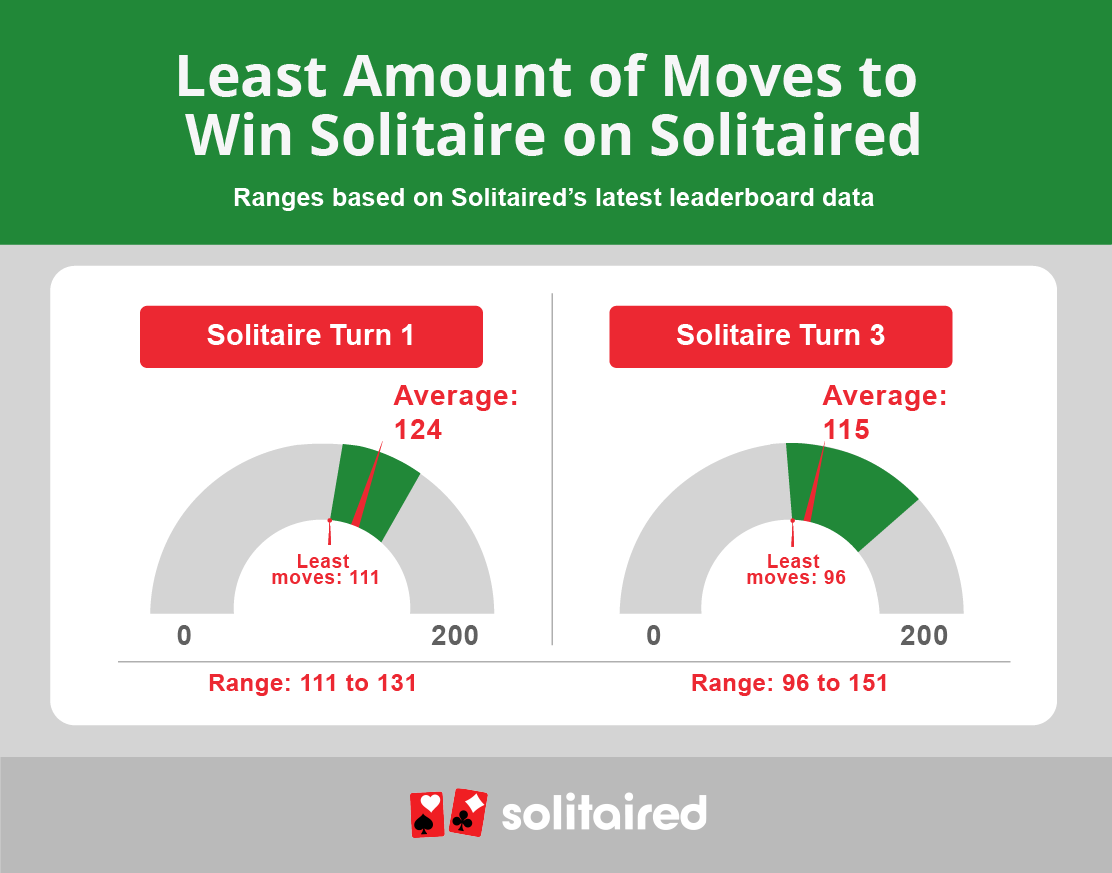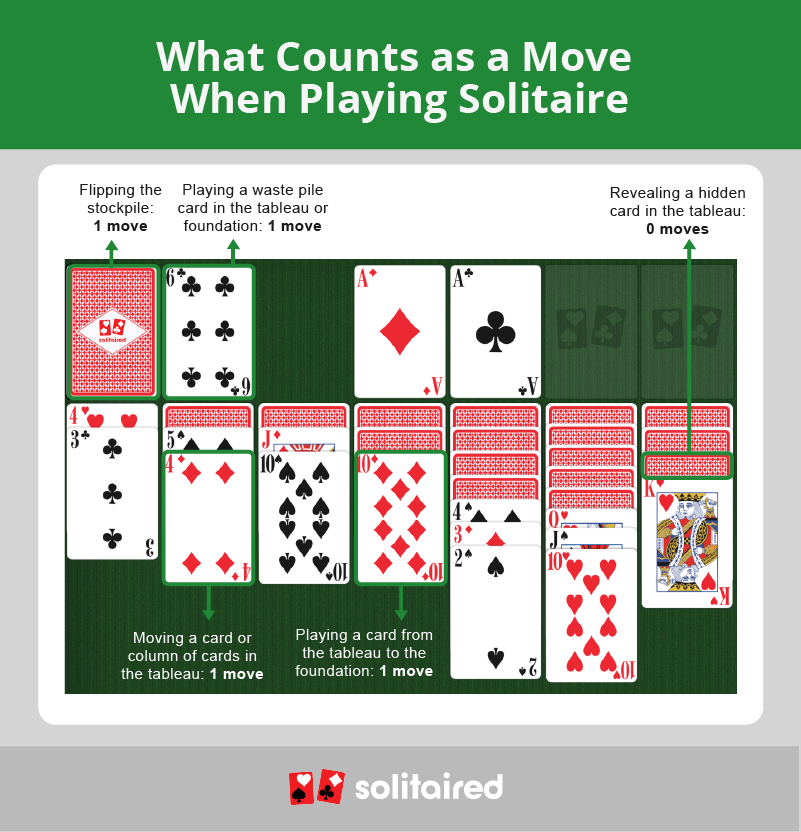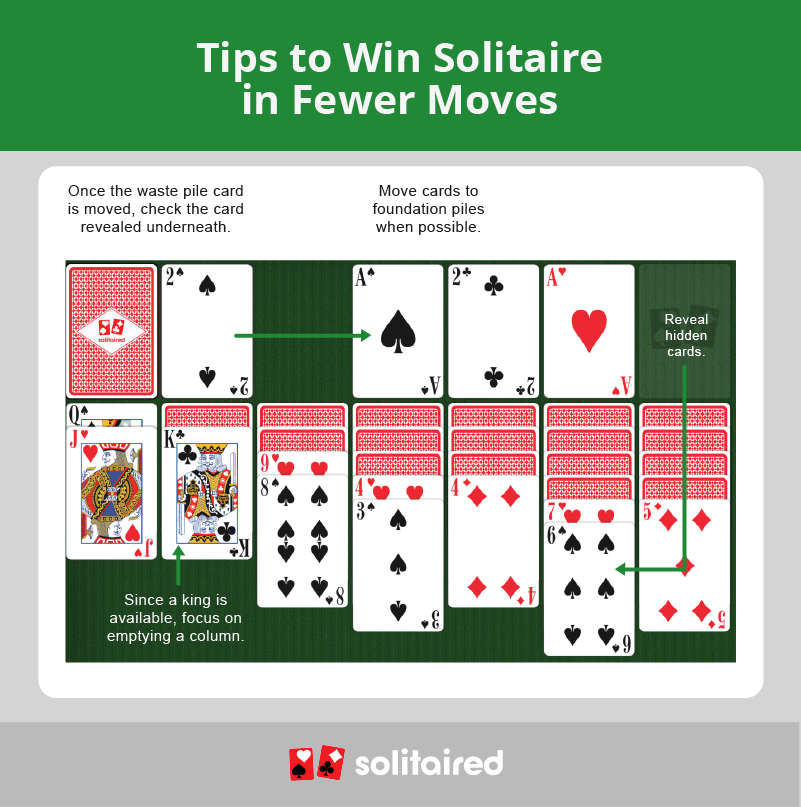The Least Amount of Moves to Win Solitaire? Statistics & Tips
By Neal Taparia - 02/07/2025
The least amount of moves it takes to win Solitaire all depends on where you play the game and which variation of Solitaire you play. Based on recent leaderboard data on Solitaired, the lowest number of moves to win Solitaire Turn 1 was 111 with a score of 141, and the lowest for Solitaire Turn 3 was 96 with a score of 134.
The goal of Classic Solitaire is to move each card to a foundation pile, sorted by suit and ascending in order from ace to king. The card game, however, has many unknown elements—a seven-column tableau with hidden cards and a 24-card stockpile—all of which add to the challenge of this single-player game and impact the number of moves it takes to win.
If your competitive spirit wants to make it to the leader board with the least number of moves, you need to know how to play Solitaire with strategy. This post explains how move totals are calculated for Klondike Solitaire and offers strategies to help you win in the fewest moves possible.
What Is the Least Amount of Moves to Win Solitaire?
It typically takes on average 124 moves to win a game of Solitaire. For a perfect game, you’d need each card to move to the foundation pile without arranging a single card on the tableau, which is unrealistic and can only happen when the cards are dealt perfectly.
Some claim that a perfect game of Solitaire is 52 moves, but that could only work if moving a card is the only thing that counts as a move. Most sites count other moves, such as flipping a stockpile card, in the total move count. So a perfect game would be 76 moves for Turn 1 and just 60 for Turn 3.

Just like the differences in how Solitaire is scored, how you play and where you play determine the least amount of moves you can make to win. These factors all impact card movement totals:
- Different sites count moves differently. While most game sites will count a card moving in the tableau or to its foundation as a move, they can all differ on whether other movements, such as flipping stockpile cards or revealing hidden cards, are counted. So what is the least amount of moves to win Solitaire on one site could be higher or lower for the same game on another site.
- Some sites play moves automatically. Some game sites automatically make moves when you set off a chain reaction, giving you less control over gameplay. So if you’re trying to make the least amount of moves, the automated movement could interfere with your strategy. You may be able to turn this off in the game’s settings.
- Versions matter. If flipping from the stockpile is counted as a move, it takes more moves to win a game of Solitaire Turn 1 than it does to win Solitaire Turn 3 because you treat the stockpile differently. You flip three cards from the stockpile at a time with Turn 3, which counts as one move, so you can cycle through and use the stockpile in fewer moves than flipping single cards in Turn 1.
The Minimum Amount of Moves to Win Solitaire on Solitaired
Based on the latest information from the Solitaired leaderboard, for Solitaire Turn 1, the lowest number of moves to win that game was 111 for a score of 141, and the lowest moves used to win ranged from 111 to 131 with an average of 124. For Solitaire Turn 3, the minimum number of moves used to win that game was 96 for a score of 134, and the lowest moves used ranged from 96 to 151 with an average of 115.
If your goal is to make the least amount of moves possible to win a Solitaire card game, you need to know what does and doesn’t count as moves for both Solitaire Turn 1 and Turn 3 on Solitaired:
- Flipping from the stockpile into the waste pile: 1 move
- Playing a waste pile card in the tableau: 1 move
- Moving a card or column of cards on the tableau: 1 move
- Moving a card from the waste pile or tableau to a foundation pile: 1 move
- Revealing a hidden card in the tableau: 0 moves

The Solitaire set up for both Turn 1 and Turn 3 are the same. Each version has a tableau of seven columns of cards, most of which are facedown. Each column has the same number of cards as its order number—so the first column has one card, the second has two, and so on—and the last card dealt into each column is face up with all others facedown. Then the 24 playing cards left over are placed into the stockpile facedown with room reserved at the top for four foundation piles.
To win Solitaire, you must move all the cards to their foundation piles in ascending order (ace to king), separated by suit. You access cards by arranging them within the tableau in descending order and alternating in color, and then you move cards as they become available to their foundation piles. Any card or column of cards moved in the tableau counts as 1 move, and each card moved to the foundation pile also counts as 1 move.
When you’re stuck during gameplay, you can turn over one (Turn 1) or three (Turn 3) cards at a time from the stockpile, depending on the version you’re playing. When you turn over stockpile cards, that counts as 1 move whether you turn over one card or three at one time. Then the face-up card in the waste pile is available to play. You can uncover hidden cards in the tableau by moving the card or column of cards on top of them. While moving a card or column of cards counts as 1 move, the facedown card being flipped over does not count as a move.
How to Win Solitaire in Fewer Moves
To win in the fewest moves, you have to make the right movements while balancing Solitaire strategies. These sections explain how to prioritize your moves and weigh them against your overall strategy to make the most efficient plays.

Move Cards to Foundation Piles When Available
You win by moving all cards to their foundation piles, and focusing on getting cards to their piles helps you win with the least moves.
Avoid moving cards around the tableau, which costs you a move, if they can be placed in a foundation pile. If you place a card from the waste pile or tableau directly into the foundation pile first, it’s considered 1 move, but if you arrange it in the tableau (1 move) and then move it to the foundation (1 move), the tableau movement adds an extra move for 2 moves total.
While placing cards in the foundation should be a high priority, you must balance this against the strategy of keeping your foundation piles even, within about two ranks of each other. If your piles differ by more than two or three ranks, you can lock in a card that you may need in the tableau to help build sequences and reveal hidden cards.
For example, if your foundation pile for spades is built to a five, but you’ve only just begun the other foundation piles with an ace and a two, you’ve locked in a black three, four, and five. You may need these cards, and it will cost you an additional move to move each card from the foundation pile.
Reveal Facedown Cards Strategically
You need to know what those hidden cards are in the tableau to make an efficient plan for moves. Even if you can’t use them yet, revealing hidden cards gives you more cards to work with, and flipping those facedown cards over costs 0 moves.
So prioritize columns with the most hidden cards because once you remove all the face-up cards, the hidden card will be revealed and is available to play. As you reveal hidden cards, first move them to the foundation, if possible—as long as piles are kept even—then look for opportunities to use them in the tableau.
Only Empty Columns for a King
It may seem like a good idea to empty a column and build a lengthy sequence, but you waste moves by emptying a column if you don’t have a king to move into the empty space. So don’t prioritize emptying columns just to empty a column. While you need to reveal every facedown card in a column, stop short of moving the last one unless you have a king. Otherwise, you spend 1 move for nothing.
For example, if a red seven is the last card in a column and you have a black eight it can be placed on, moving it is a wasted move unless you can place a king from your waste pile or one hiding facedown cards in the column. You can still build on the seven whether it’s on the eight or on its own. So keep the seven where it is and save yourself a move if a king that is useful to move can’t fill the space.
Use the Stockpile with Purpose
Especially as a beginner, many strategies suggest flipping through the stockpile to discover the hidden cards, but each flip costs you 1 move. Unlike hidden cards flipped in the tableau, flipping a facedown stockpile card counts as 1 move.
Because cycling through the stockpile doesn’t help you win in the least amount of moves, utilize the stockpile as a last resort. The stockpile should feed cards to your waste pile that unlock possible moves when you’re blocked from arranging cards in the tableau. So spend more time creating sequences in the tableau than flipping through the stockpile, and use the stockpile only when you need new cards to unlock future moves.
Check for Revealed Waste Pile Cards
If you have to use the stockpile and are able to play a waste pile card, be sure to use any cards that are revealed underneath. Otherwise, you’ll need to flip through the stockpile again to retrieve it, costing you even more moves.
For Solitaire Turn 3, checking the waste pile cards is key to minimizing moves, especially if you understand the difference between Turn 3 and Turn 1. In Solitaire Turn 1, if you flip a card into the waste pile, it costs you 1 move, and to move it to the foundation or tableau also costs 1 move, for a total of 2 moves.
Playing it allows you to play the card that is under it in the waste pile. However, because that other waste pile card had to be flipped into the pile previously (1 move), even if you can play it, you’re still accumulating 2 moves. Regardless, playing it immediately keeps you from wasting more moves cycling back through the stockpile to retrieve it.
On the other hand, for Turn 3, it still costs 1 move to flip from the stockpile, but that flip offers three cards. So if you play the first card (for a total of 2 moves, 1 for flipping and 1 for playing), you can play the card that is revealed underneath and tally just 1 additional move. You spend 1 move by placing it in the tableau of a foundation pile, but it didn’t cost you a move to flip it over. So the other two cards you get in Turn 3 are like getting free flips from the stockpile. Don’t ignore them when they’re revealed in your waste pile.
Try to Avoid the Undo Button
For beginner Solitaire players, the undo button can be quite helpful. You can use it to undo as many moves as you like, and it helps you learn how to strategize and plan your moves more carefully.
But this second-chance button counts as 1 move. So if you make a move (1 move) and then undo it (1 move) just to make another move (1 move), you’re working against your goal to win in as few moves as possible. If you’re trying to win with the fewest moves, you don’t have to worry about playing the fastest Solitaire game, so take a bit more time assessing the tableau so you can focus and be as deliberate as possible to avoid using the undo button.
Is Every Game of Solitaire Winnable?
You can’t win every game of Solitaire, and some versions are more difficult than others. Solitaired data reveals that the win rate for Solitaire Turn 1 is 33%, but Turn 3 is more difficult, with a win rate just 11.1%.
- Klondike Solitaire Turn 1 has a higher win rate because you can access each stockpile card as you cycle through it. You’re not blocked from using any card in the stockpile because you turn just one card over at a time, but you trade off moves for this easy access to stockpile cards. The least number of moves to win Solitaire Turn 1 range from 111 to 131, with an average of 124 moves.
- Klondike Solitaire Turn 3, on the other hand, has a low-move range from 96 to 151, with an average of 115 moves. While you can win Turn 3 in fewer moves, it’s more difficult than Turn 1 since you have to flip three cards at a time from the stockpile. You can only play the top card from this group of three, so if you can’t play that card, you also can’t access the cards turned with it.
Variations to Challenge Your Moves
If you enjoy playing Solitaire and want to try other types of Solitaire to see if you can win those in the fewest moves, try these variations:
- FreeCell Solitaire: An easier version than Classic Solitaire, FreeCell gives you four free cells to use as temporary placeholders as you arrange cards in the tableau. The win rate for FreeCell Solitaire is 41.86%, and the lowest number of moves in which this game has been won range from 73 to 100 with an average of 87.
- Spider Solitaire: Played differently than Classic Solitaire, you create sequences in the tableau that descend in order by suit, and then those sequences are transferred to a foundation pile. The easiest version is 1 Suit Spider Solitaire with a win rate of 52.29%, and the least number of moves in which it was won range from 94 to 109 with an average of 101. Spider gets more difficult as you add suits—2 Suit Spider Solitaire has a win rate of 16.6% a 4 Suit Spider Solitaire has a win rate of 6.2%.
- Pyramid Solitaire: Pyramid is a pairing Solitaire game. Instead of building sequences, you pair cards together that equal 13 and move the pairs to the foundation pile. This game sounds simple, but it’s slightly more difficult to win than Solitaire Turn 1 or FreeCell, with a win rate of just 30%. You can win this game in fewer moves because you only flip from the stockpile and then pair the card, and the deck only has 26 pairs. The range of the fewest moves to win is from 61 to 80, with an average of 70.
Practice Using the Fewest Moves to Win Solitaire
Winning Solitaire and seeing yourself featured on the leaderboard is fun, but winning in the least amount of moves gives you some real bragging rights. So play classic Solitaire for free online at Solitaired, and practice making the most efficient moves to win the game.
About the author

